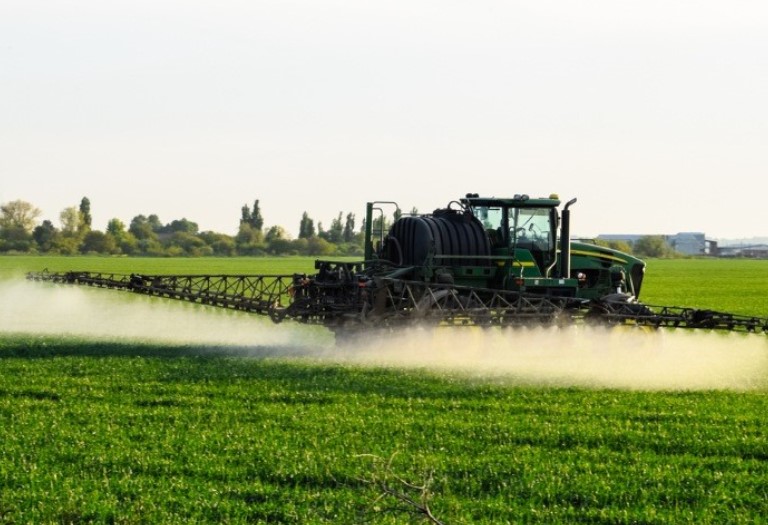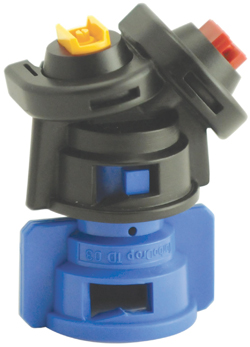No two growing seasons are the same. Every year brings unique fluctuations in temperature, varying amounts of precipitation, and different pests which thrive in these various conditions. These many variables make the choice of when to apply fungicides - and which one you should use - a complex decision. Expert guidance is often required to ensure you get the most out of fungicide treatment on your crops.
The type of sprayer nozzle you use to apply fungicides is just as important as the choice of fungicide itself. The right type of nozzle can significantly enhance the effectiveness of your application, thereby reducing the likelihood of reapplication or subpar results. While I cannot help you decide the best time to apply, I can help you identify the sprayer nozzles that are excellent for use with fungicides.

Understanding Nozzle Requirements for Fungicide Application
Nozzles play a crucial role in how successful a fungicide treatment can be, including determining the amount of chemical applied, the uniformity of the application, and the potential drift. Different nozzles produce varying droplet size ranges and spray angles. These attributes provide benefits like improved drift reduction, greater canopy penetration, and more precise spray direction.
In this guide we are going to be referring to the droplet size classification and spray patterns of several different nozzles. If you are not familiar with how spray nozzle droplets are classified, be sure to read this guide to nozzle droplets first.
As with other spray nozzle applications, the nozzle type you need will depend on your specific fungicide, target pest, crop type, etc. Spray nozzles are not specifically designed for a certain pesticide or fungicide. Instead, they are manufactured to provide specific performance traits. These include GPM, droplet size, spray pattern shape, spray angles, etc.
Finding the best nozzle requires examining the mode of action (or the means a fungicide uses to eliminate the pest) of fungicide you are using and then identifying a nozzle that can most effectively deliver the liquid to the target surface. It is recommended to always consult an agronomist or local crop care specialist when choosing a fungicide for your unique needs. Here, though, are general guidelines for different types of fungicides:
Contact Fungicides
Contact fungicides require thorough coverage of the leaf surfaces to be effective. These fungicides stay on the surface of the foliage and need to cover the entire leaf area to prevent or control the disease. Therefore, it is essential to use nozzles that produce fine to medium droplets. Fine droplets provide a larger number of droplets per unit area, enhancing the coverage and ensuring that all leaf surfaces are uniformly coated.
Systemic Fungicides
Systemic fungicides need to reach the lower canopy or soil surface, where they can be absorbed by the plant and translocated to the site of action. These fungicides are typically taken up by the roots, making it important to ensure that the droplets can penetrate the plant canopy and reach these areas. Coarse to very coarse droplets are suitable for systemic fungicides as they are less likely to drift and can more effectively deposit the fungicide at the base of the plant.
Recommended Spray Nozzles for Fungicides
When you have identified all the aspects of your scenario, fungicide type, crop type, etc., you can then look at the various nozzles that are recommended for fungicides. Nozzle manufacturers can provide guidance on which of their nozzles will produce the needed coverage and droplet size.
Wilger Spray Nozzles for Fungicides
To provide expert insight into the effectiveness of spray applications, I reached out to Chris Bartel from Wilger Inc. Chris shared his expertise and emphasized the importance of achieving optimal coverage in fungicide and insecticide applications.
"The goal of a fungicide/insecticide contact application is to have complete coverage in the application zone. The more droplets that are in the spray application, the more effective it will be in providing complete coverage. This is done with higher gallons per acre rates coupled with nozzles that are more focused on providing coverage than drift control with a medium or coarse droplet spectrum."
Chris continued, noting the different options operators have for achieving the best coverage possible. "Combining nozzles in a double down (2 nozzles side-by-side in a straight down orientation) or dual angle (nozzles oriented at an angle forward and backward) application can also allow for better coverage in dense canopy applications by combining tips with different droplet spectrums to get deeper canopy penetration and complete coverage of the entire plant top to bottom."
Wilger offers a wide range of spray nozzles, but these two series they offer provide optimal performance when fungicides are involved.
- Droplet Size: Fine to Extremely Coarse
- Excellent for Fungicides
- Provides fine droplet for excellent coverage in applications where drift is not a concern.

Wilger ER Series Nozzles
- Droplet Size: Fine to Ultra Coarse
- Excellent for contact fungicides
- Provides about 50% fewer driftable fines compared to the ER series.
Greenleaf Technologies Spray Nozzles for Fungicides
"Fungicide application is coverage critical, so we would recommend using a DualFan nozzle of some sort" said Clay DeGruy, a spray nozzle specialist with Greenleaf Technologies. Clay's statement reinforces the importance of coverage in fungicide applications, and Greenleaf offers several nozzles that fit that objective.
TurboDrop XL (TDXL), Turbo Drop XL-D (TDXL-D)
- Droplet Size: Medium to Extremely Coarse (Very Coarse to Ultra Coarse produced by TDXL-D)
- Excellent with contact fungicides and systemic fungicides
- Advantages: Designed for higher pressures (60-120 psi), providing excellent drift control and coverage. Ideal for penetrating dense crop canopies.
AirMix (AM)
- Droplet Size: Medium to Coarse
- Excellent with contact and systemic fungicides
- Advantages: Operates effectively at lower pressures (15-30 psi), reduces drift while maintaining good coverage.
TurboDrop DualFan (TADF)
- Droplet Size: Fine to Extremely Coarse
- Excellent for Systemic and Contact Fungicides
- Advantages: Suitable for a wide pressure range (30-120 psi), featuring dual spray fans for improved coverage and reduced drift.

Greenleaf DualFan Nozzle
TeeJet Spray Nozzles for Fungicides
Turbo TeeJet Wide Angle Flat Spray Tips (TT)
- Droplet Size: Fine to Coarse
- Excellent for contact fungicides and very good for systemic fungicides.
- Advantages: Fine droplets provide best coverage in conditions where drift is not a concern.
Extended-Range Flat-Fan Nozzles (XR)
- Droplet Size: Fine to Coarse
- Excellent for contact fungicides and good for systemic fungicides
- Advantages: Provides excellent spray distribution over a wide range of pressures, making them versatile and effective for various applications.
Turbo TwinJet (TTJ60)
- Droplet Size: Medium to Very Coarse
- Excellent for contact fungicides, very good for systemic. Superior leaf coverage and canopy penetration
- Advantages: Dual spray fans provide two passes in one application, hitting the target from two different spray angles increasing the chances of reaching plant surface.

Turbo TwinJet Nozzle
AI Turbo TwinJet (AITTJ)
- Droplet Size: Medium to Ultra Coarse
- Excellent for systemic fungicides. Very good for contact fungicides
- Advantages: Dual fans to provide increased number droplets and coverage while still creating coarser droplets to mitigate drift.
AI3070 Air-Induction Dual Pattern
- Droplet Size: Medium to Ultra Coarse
- Excellent for fungicide application in wheat and other cereal grains
- Advantages: The 30° forward-tilted spray effectively penetrates dense crop canopies, while the 70° backward-tilted spray effectively targets the spike or head of grain.
Hypro Spray Nozzles for Fungicide
- Droplet Size: Fine to Very Coarse
- Excellent for fungicide
- Advantages: Wide 120-degree pattern and tilted fan allows user to spray forward or rearward to suit your application.
- Droplet Size: Medium to Very Coarse
- Excellent for fungicide application
- Advantages: More droplets per gallon produced by dual fan pattern.
Keys to Remember When Selecting Spray Nozzles for Fungicides
Whenever you are selecting a spray nozzle, it is important to follow the label on the product you are using. Also, there may be more than one type of nozzle that can give you excellent results. The key is to consider the needs of your specific application and then identify a nozzle that will provide the necessary spray pattern, droplet size, etc. Whatever type of fungicide you decide to apply you know you can identify a nozzle that will give you effective results.
For help finding or sizing a sprayer nozzle contact our sales team. You can also read our other resources on sprayer nozzles:
- How to Size a Sprayer Nozzle
- Sizing a PWM Spray Nozzle
- GPM Calculator
- Guide to Sprayer Nozzle Numbers
- Understand Spray Nozzle Droplet Sizes

Tech Ag & Industrial Sales
Shane Blomendahl is a tech sales veteran at Dultmeier Sales with over 10+ years of experience in liquid handling products covering several industries and applications.












